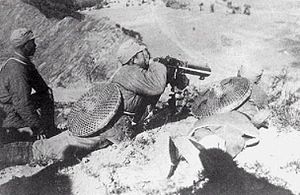
Back Пинсингуанска битка Bulgarian Slaget ved Pingxingguan Danish Schlacht von Pingxingguan German Batalla de Pingxingguan Spanish نبرد گذرگاه پینگشیانگ FA Pingxingguanin taistelu Finnish Bataille de Pingxingguan French Pertempuran Pingxingguan ID Slaget ved Pingxingguan NB Пинсингуаньское сражение Russian
This article needs additional citations for verification. (September 2012) |
| Battle of Pingxingguan | |||||||
|---|---|---|---|---|---|---|---|
| Part of the Second Sino-Japanese War | |||||||
 Chinese soldiers firing a Type 24 heavy machine gun at an ambush against Japanese troops in the Battle of Pingxing Pass | |||||||
| |||||||
| Belligerents | |||||||
|
|
| ||||||
| Commanders and leaders | |||||||
|
Lin Biao Zhu De | Itagaki Seishiro | ||||||
| Units involved | |||||||
|
|
| ||||||
| Strength | |||||||
| 6,000 troops of the 115th Division | 15,000 troops (5th Division); however, only certain supply troops and the 3rd Battalion of the 21st Regiment were involved in the actual ambush | ||||||
| Casualties and losses | |||||||
| ~400[1] |
400–500[1] 165 killed, 75 wounded[2] | ||||||
The Battle of Pingxingguan (Chinese: 平型關戰役), commonly called the Great Victory of Pingxingguan in Mainland China, was an engagement fought on 25 September 1937, at the beginning of the Second Sino-Japanese War, between the Eighth Route Army of the Chinese Communist Party and the Imperial Japanese Army.[3]
The battle resulted in the loss of 400 to 600 soldiers on both sides, but the Chinese captured 100 trucks full of supplies. The victory gave the Chinese Communists a tremendous boost since it was the only division-size battle that they fought during the entire war.[3]
- ^ a b Cite error: The named reference
yangwas invoked but never defined (see the help page). - ^ "姜克實:平型關戰役日軍死傷統計". 2016. Retrieved 13 November 2024.
- ^ a b Spencer C. Tucker (2009). A Global Chronology of Conflict: From the Ancient World to the Modern Middle East. ABC-CLIO. ISBN 9781851096725.